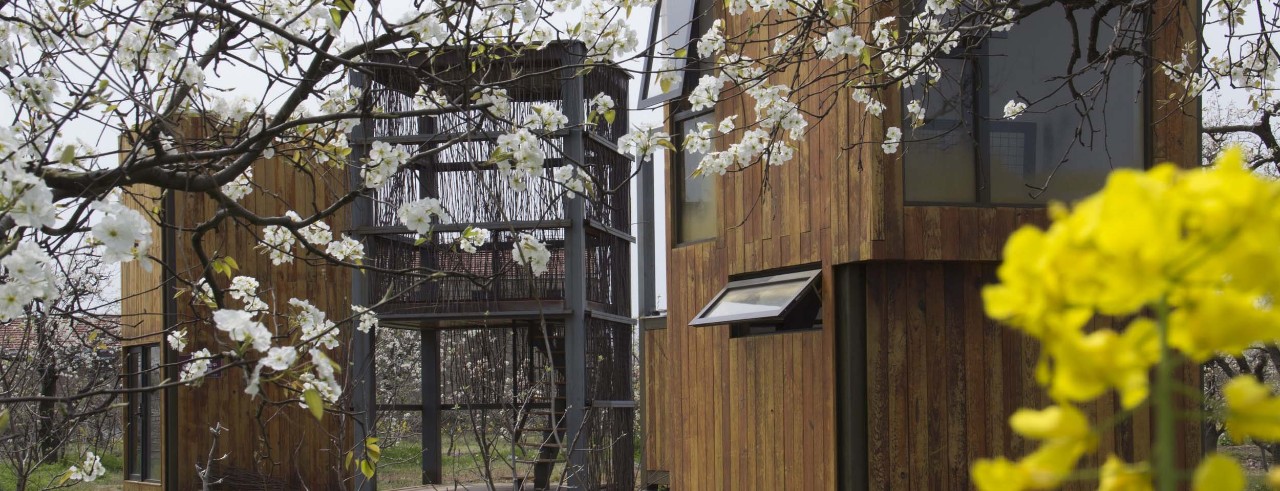
New Book: UC architecture students collaborate, compete internationally
Global design-build competition inspires book about UC-Beijing collaboration
An international experiential learning project from the pre-pandemic spring and summer semesters of 2019 is still bearing fruit with the publication this summer of “Architectural Interventions: Design-Build Collaboration on the Global Scale.”
Authors Ming Tang, Whitney Hamaker and Edward Mitchell of the School of Architecture & Interior Design in the College of Design, Architecture, Art & Planning at the University of Cincinnati and Yingdong Hu of the School of Architecture & Design at Beijing Jiaotong University recount the collaboration between Tang and Hu’s undergraduate architecture students in a global student competition to design and build community structures for Guoyuan Village, a rural village north of Shanghai that is famous for its centuries-old white pear orchards. The competition was part of an effort to promote community development and tourism outside of China’s megacities.
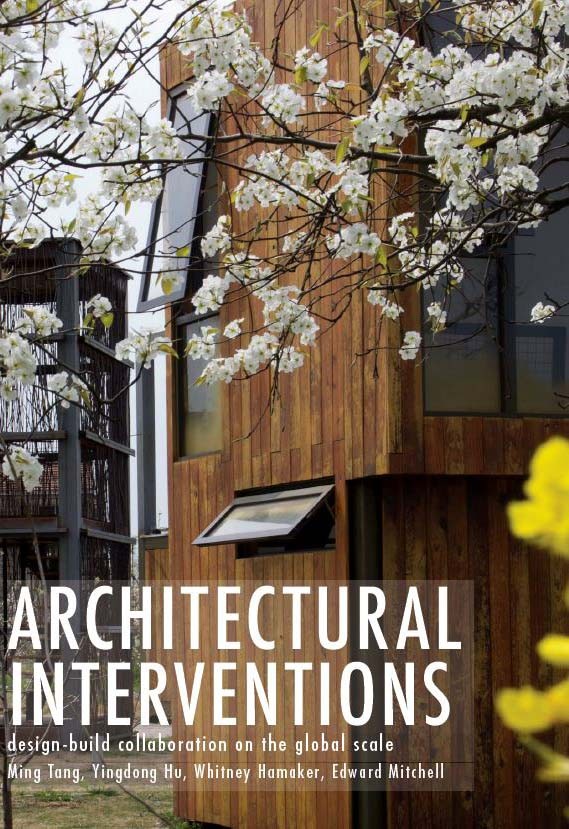
Cover of "Architectural Interventions," by UC faculty members Ming Tang, Whitney Hamaker and Edward Mitchell and Beijing Jiaotong University faculty member Yingdong Hu.
Based on a design by UC students Lauren Figley, Pat McQuillen, Jordan Micham, Andi Moore and Vu Tran, the joint UC/BJTU proposal was one of 15 entries (out of more than 100 by university teams from 23 countries) that was selected to be built in the competition’s second phase. In August 2019, the UC team, led by Hamaker, traveled to China to join their BJTU teammates onsite to construct six tiny buildings in only 11 days. Their work won third place.
With their new book, the authors hope to pass along lessons they and their students learned about international partnership, integrating design-build projects into curricula, working and collaborating using digital tools, and creating thoughtful, sustainable designs that serve the needs of a community.
“It is an aspiration for an architect to reach the community and help people through responsible and respectful designs,” said Tang, who is an associate professor in SAID. “The built environment is so powerful to transform society and make people’s lives better, and the strategies of fostering community development through building environments are global.”
The story of the hands-on experience highlights UC’s Next Lives Here vision of real-world impact on an international scale. UC, the founder of university co-op programming, continues to expand integrated work/learning opportunities to prepare all students for the global workplace.
The collaboration also demonstrates the strength of UC’s strategic partnership with BJTU. The multidisciplinary partnership, more than three decades old, focuses on sustainable urbanism and continues to expand across colleges.
Design: Digital meets traditional
The project began in Tang’s spring 2019 Digital Media class, a course that teaches third-year architecture students about digital design, modeling and fabrication tools.
A design-build project may seem like an odd choice for a computer skills course, but Tang wanted his students to connect the onscreen and onsite aspects of their profession. His course heavily emphasized prototyping (building working models to anticipate construction problems) instead of representation (making digital renderings of a proposed structure).
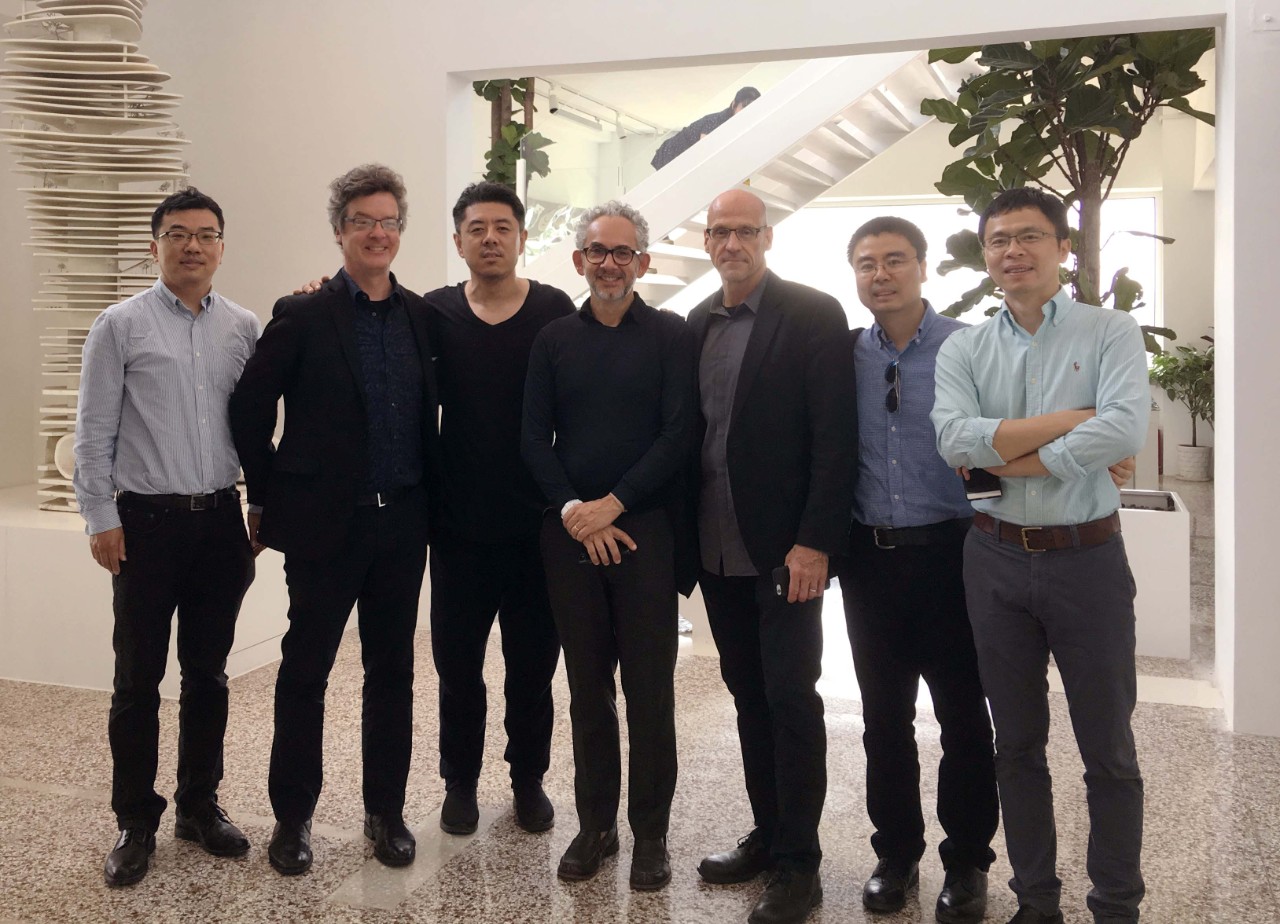
UC faculty members Edward Mitchell (second from left) and Ming Tang (second from right) with BJTU's Yingdong Hu (left) and other hosts during a 2018 DAAP trip to Beijing. Photo courtesy Beijing Jiaotong University.
The idea for the two UC and BJTU classes to enter the “Pear Orchard Cabins” competition came from Hu, an associate professor at BJTU/SAAD. Hu had just visited UC as a visiting scholar, and he and Tang had collaborated several times before.
“For many years we have brought students to China, usually to major cities like Beijing. We had seminars, symposiums with city planners and architects to discuss the new development and the environmental and social issues of megacities in China,” Tang said. “The effort was quite concentrated in the large cities. The 2019 design-build project is the first time we shifted our entire focus to rural China, which is facing many crises due to the rapid urbanization in the past decade.”
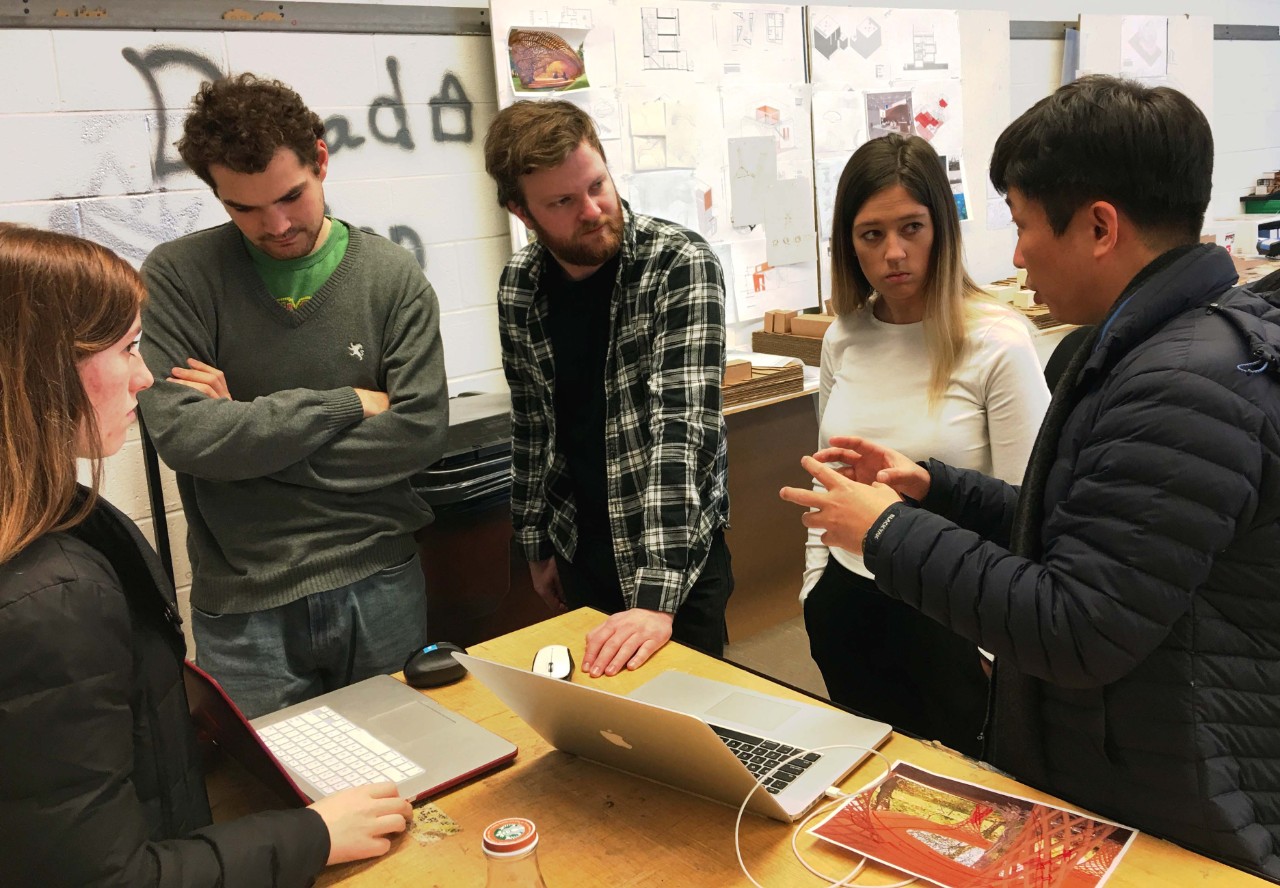
UC students in Ming Tang’s digital design class consult with Visiting Scholar Yongquan Chen. Photo by Ming Tang.
Tang’s large core class and Hu’s smaller studio class worked in parallel, with teams designing more than 20 proposals. Three Chinese visiting scholars of architecture and landscape design, Xiangbin Xu, Yuhui Song and Yongquan Chen, advised Tang’s class to make sure that proposals fit the cultural context of the project.
Designs proposed for the UIC-AIC competition, sponsored by regional building authorities and China’s Ministry of Education, were required to promote the social events of Guoyuan Village and support the tourists who flock every April to view the famed pear orchards the villagers have tended for generations.
The joint UC/BJTU submission, called “A Millet in the Sea of Flowers” to connote the lightest possible intervention in the landscape, proposed six tiny structures scaled to fit within the orchard grid: three multipurpose cabins that look out over the treetops and can be used by either farmers or seasonal tourists, a viewing tower, a community teahouse and a public restroom.
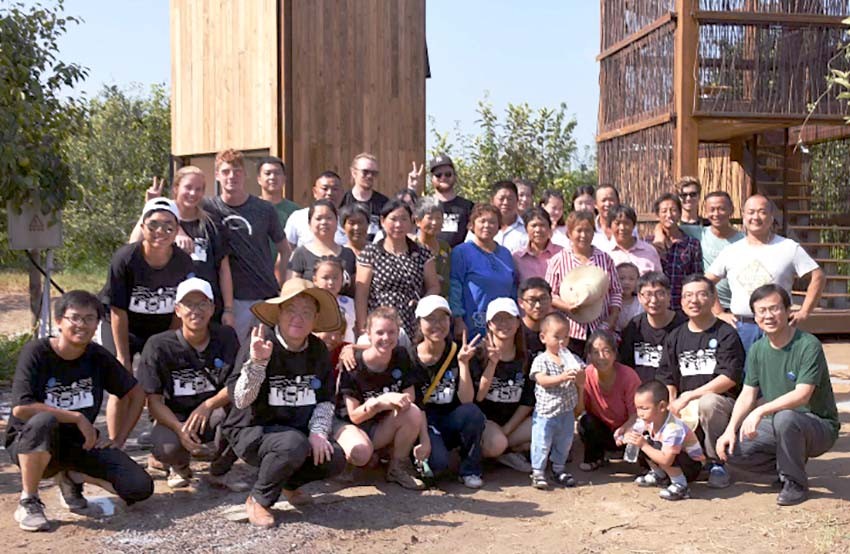
The UC/BJTU group with some of the villagers on the site of their build. Photo by CBC and UIC-AIC competition photographer, from the book.
Build: On site in Guoyuan Village
Four of the five undergrads from the original UC design team were able to travel to China in August 2019 for the build phase of the competition. They were accompanied by graduate assistants Jeremy Swafford and Tess Ryan and were led by Hamaker, as Tang was unavailable. Hu and nine of his undergrads joined them, with visits by other BJTU faculty members.
Hamaker is an advocate for “thinking through making.” He has led multiple design-build studios and projects, including the award-winning Kamama Prairie tiny house in 2016 in Adams County for the Arc of Appalachia, a nonprofit that preserves the region’s environmental heritage. He also worked on the UC Solar House, a multi-semester project, as a master’s student at UC in 2006-2007.
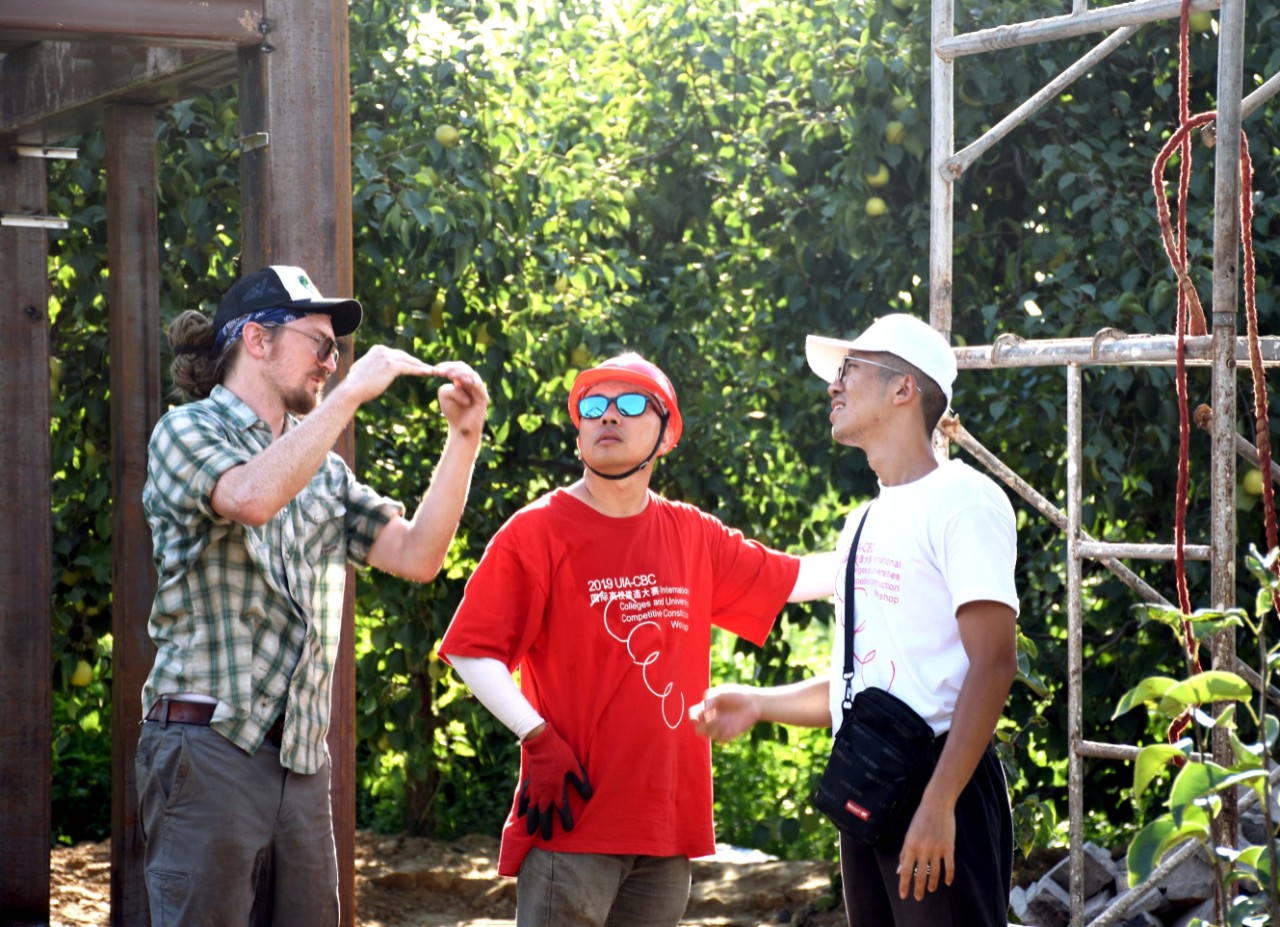
UC's Whitney Hamaker discusses a construction issue with Yingdong Hu and BJTU student leader Zhou Chen. Photo from the book.
He said “parachuting” into the project at such a late stage to help develop working drawings and anticipate logistical problems is a process he enjoys. But adapting to Chinese work practices (which emphasize speed and onsite fabrication) and figuring out the supply chain in a rural Chinese location took some adjustments.
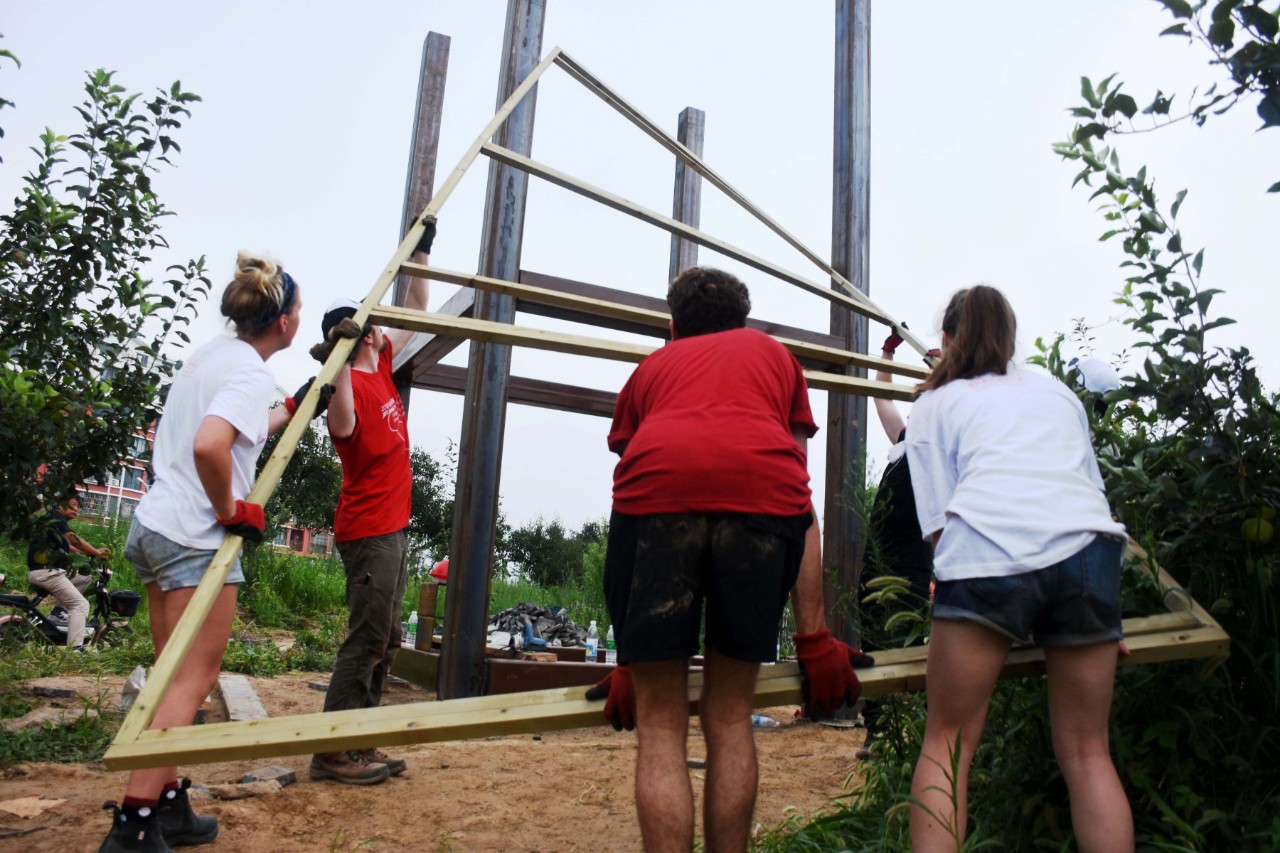
Students help lift a framing section into place. Photo from the book.
“Essentially, all the same stuff you would find at a big-box hardware store exists in these villages, but it’s spread across four or five different places. Like when we were developing the flashing detail for the roofs, we had to find a place where they sell metal, a little shop in town where guys are doing small-scale metalwork, and we looked for the galvanized flashing we needed in a thin enough gauge so we could cut it and shape it and bend it on our own.”
The two-week build—with a two-day monsoon mid-project—was an intense field experience for the students. They helped a local construction crew build the structures, with steel frames, wood facades and screens made from pear-tree branches, as well as a water collection system lined with recycled local brick. They worked all day in high heat and humidity and participated in problem-solving on the fly.
Hamaker described a moment captured in one of the photographs in the book, of him and students “chicken scratching” sketches on placemats in a fast-food restaurant.
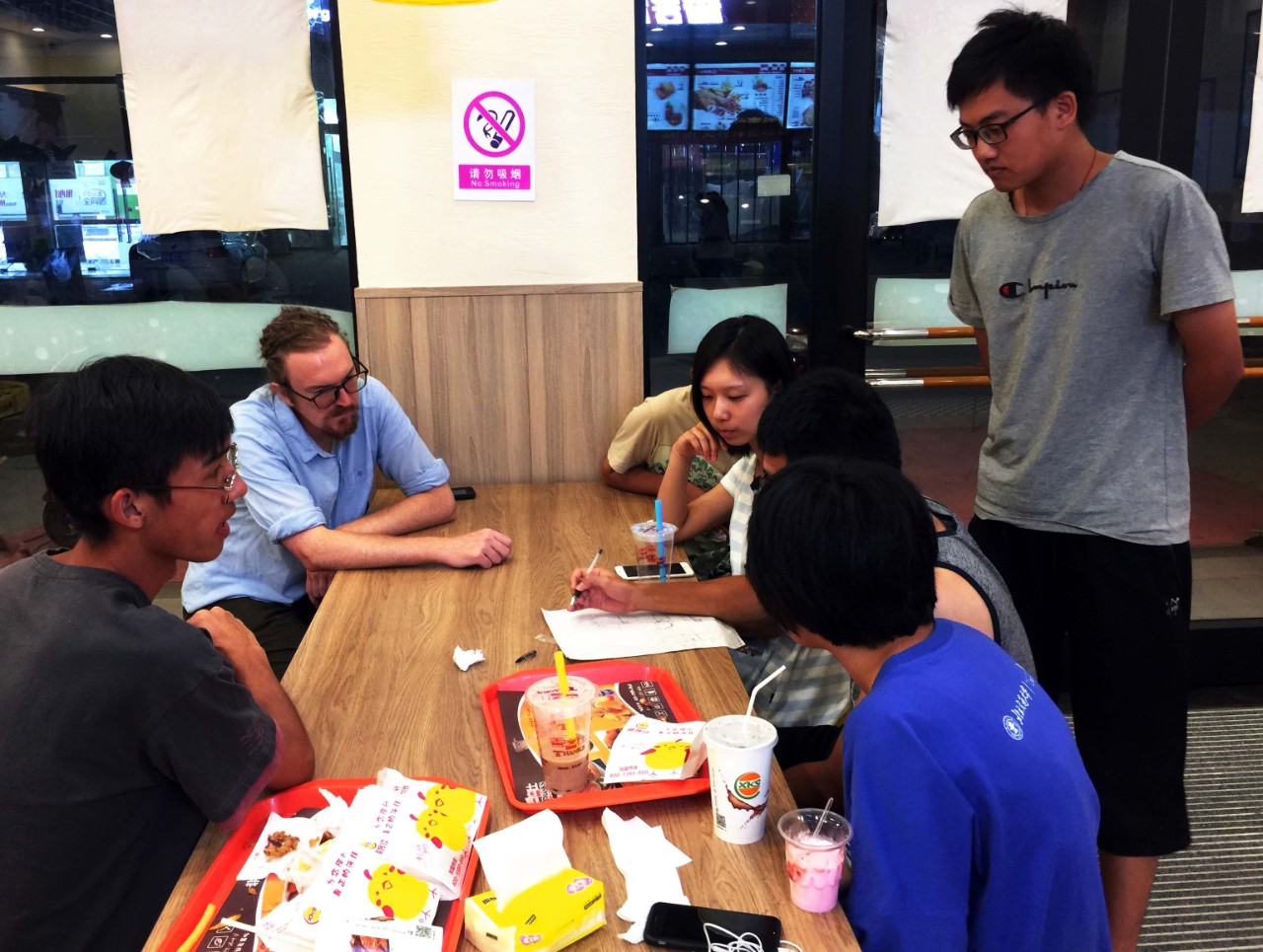
UC's Whitney Hamaker and students plan how to construct flashing for the cabin roofs. Photo from the book.
“There was literally a monsoon outside and we’re stuck sitting there inside, trying to solve details for things that hadn’t been built yet. One big thing was trying to figure out how we were going to use the steel channel that we had on site to frame the skin of the teahouse, which houses those pear branch screens,” Hamaker said. “On a project like that, there’s just a new set of those [problems] every day, because as you get further into the process, decisions you made two days ago all of the sudden create a new set of decisions that aren’t in the drawings.”
Of the 15 international projects in the final competition phase, the UC/BJTU project won third place. It later won a silver medal for ecological, healthy and sustainable design in the 2020 Asian Design Awards that focused on social or community-minded design.
Real-world impact
The project gave students experience working on international teams and being mindful of multicultural values and practices.
Tang believes that the village setting, which involved some culture shock for both the UC students and the urban BJTU students, made the project especially valuable. While construction in China’s large cities is similar to American practice, the rural project demonstrated explicitly how any design involves the community.
“I think some students believe architectural design is just sitting in the air-conditioned office doing drawings,” he said. “I think that is an illusion we probably need to make them realize. You have to reach out to the community, have to talk to the people about real issues. It's not just about doing beautiful renderings or cool models.
“That's something [that] is quite clear for students immersed in this rural construction project, because they see the villagers, they know they are part of the construction team, and they all have to work with each other, although [the villagers] don't speak English. How you communicate, how you solve problems together—I think that's a big challenge, but also extremely rewarding."
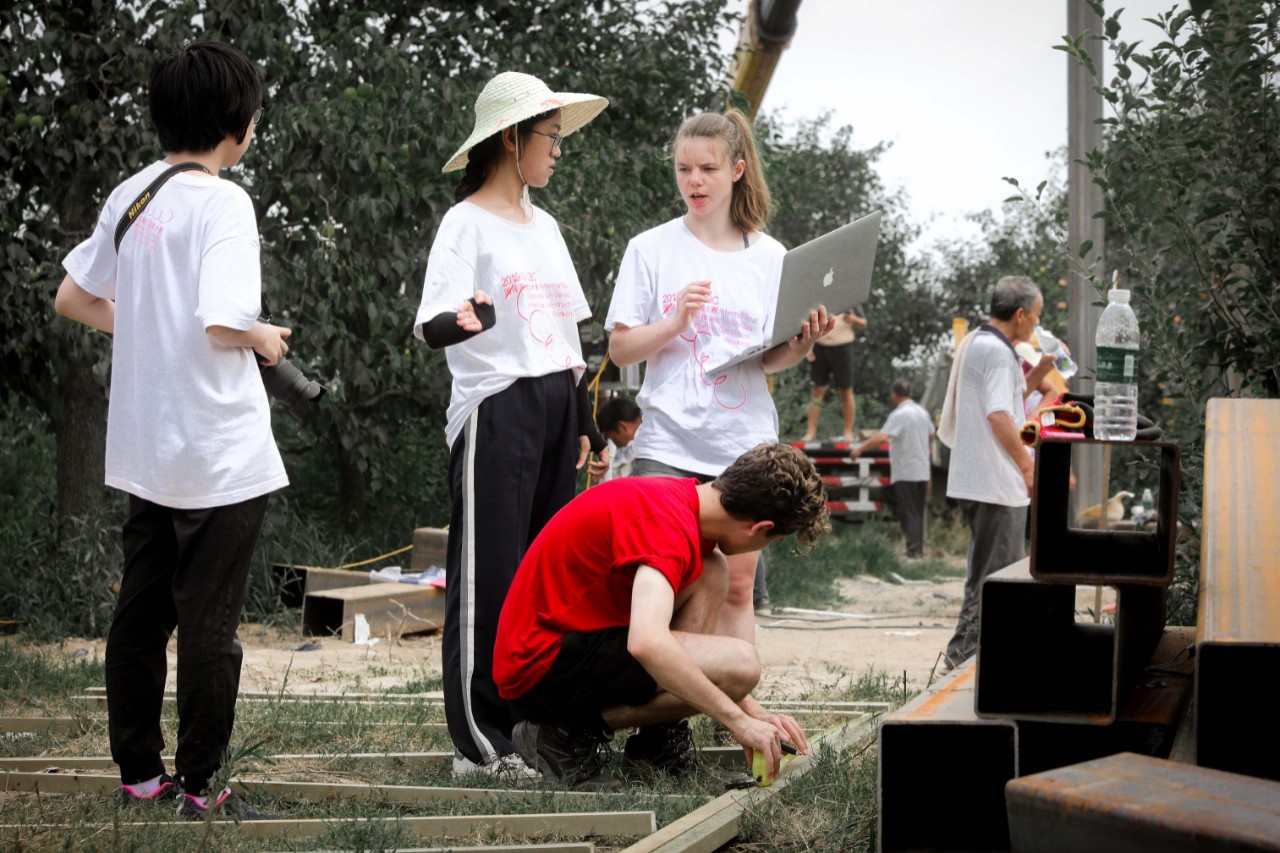
UC students Tess Ryan and Pat McQuillen work with BJTU teammates on the build site. Photo from the book.
In his essay for the book, Mitchell, director of UC’s School of Architecture & Interior Design and the new book’s fourth co-author, wrote about the importance of such real-world experience in an age of virtual design.
“The programs within [SAID] have a tradition of design-build research. Students at SAID have constructed projects for the college working in traditional and digital platforms in order to experience, first hand, the intricate complexities of construction. … The questions of why we choose to build one way rather than another [are] even more pronounced when tools and resources appear to have universal access.”
Large design-build projects are hard to incorporate in architecture programs, due to difficulties in securing funding, potential liability, and the detailed logistics involved. International projects are even more complicated. Tang thanked UC International for funding that supported the class trip and the publication of the book. Mitchell cited the school’s increasing international partnerships, especially with BJTU, that facilitate such opportunities.
Tang originally planned to travel to China after the competition to conduct research and interviews for the book, but COVID restrictions prevented his travel. Hu was able to travel back to the village after a year to see the site environment recovering from construction and to see the community using the structures.
Tang hopes to repeat the international design-build experience every few years, possibly in a different class or studio. Hamaker mentioned that he would love to see a third partner university involved, perhaps one in India. The two of them have already collaborated on another design-build project in China with BJTU and Nanchang University to build a public restroom for a rural village, although only the Nanchang students could participate in on-site construction due to COVID travel restrictions.
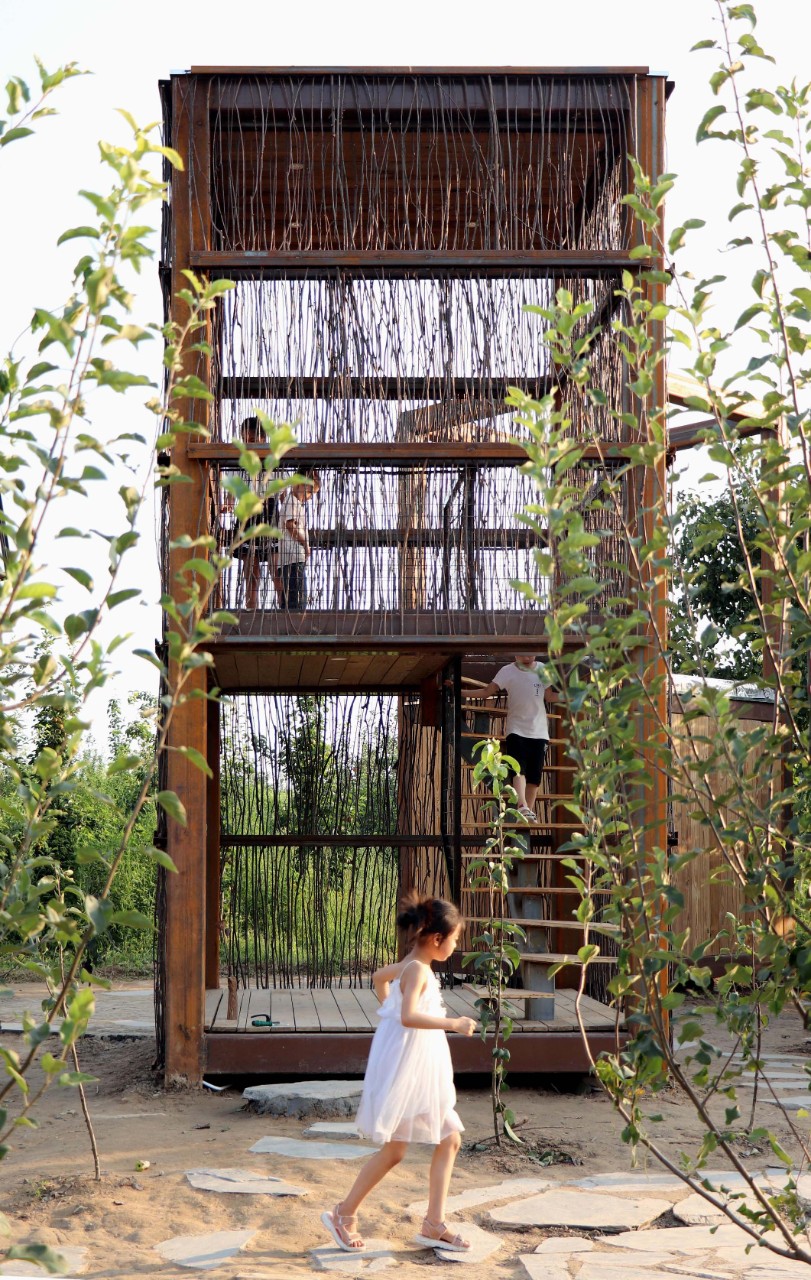
Villagers explore one of the new structures. Photo from the book.
UC International is working with programs throughout UC’s colleges to promote creative ways of offering students global experience, whether or not travel is possible. One of three new faculty fellowships the office is piloting will focus specifically on digital initiatives and another on partnerships in China.
Vice Provost for International Affairs Raj Mehta said that collaborations like the design-build project are valuable because they strengthen UC’s long-term international ties.
“Building sustainable, university-wide partnerships with leading educational institutions around the world helps us prepare our students for an increasingly global future. And these transdisciplinary partnerships support the innovative research teams that can address urgent global challenges.”
What will you discover when #UCtheWorld?
- See more pictures, as well as time-lapse and drone footage of the build, on Tang’s YouTube channel or blog.
- Read “Architectural Interventions” free on Issuu or Adobe Online, or order it from Amazon.
- For more on UC’s strategic global partnerships, visit international.uc.edu.
- For more on the new faculty fellowships, UC faculty can log into Bearcats Landing at my.uc.edu and follow UC International’s site for international news, grants and other opportunities.
Featured image: A view of the cabins amid the pear trees. Photo from the book.
Related Stories
UC joins novel bipolar research and clinical care network
March 12, 2025
The University of Cincinnati is one of four new national institutions to receive $2.3 million each to join the Breakthrough Discoveries for Thriving with Bipolar Disorder (BD²) Integrated Network, a collaborative research and clinical care model with a mission to improve care, interventions and outcomes for people living with bipolar disorder.
UC Day of Giving connects Bearcats across the globe
Event: April 8, 2025 12:00 PM
For 24 hours on April 8-9, this celebration underscores the profound impact of philanthropy and its ability to transform the UC and UC Health community.
Two DAAP Galleries have new installations, open to the public...
March 11, 2025
Two DAAP art galleries have new installations: ‘2.0 Kinds of Funny’ and ‘New to Us: A Selection of Recent Acquisitions to the UC Art Collection.’ The exhibitions serve as academic endeavors and teaching tools for both students, faculty and alumni.
